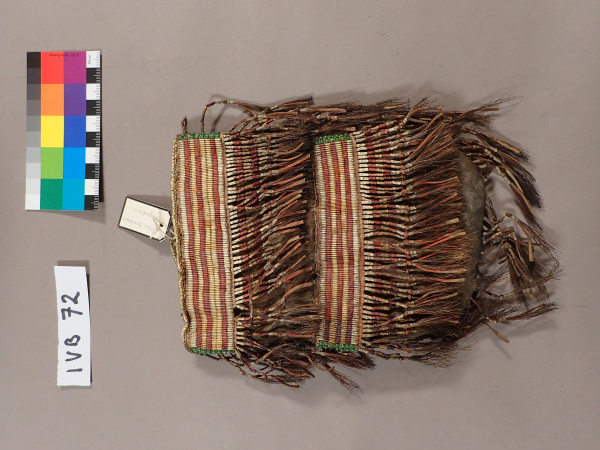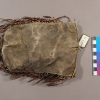pouch
pouch
pouch

















This hide pouch with two loom woven quillwork panels may be quite old, dating to the 18th century, and possibly the first half of the 18th century (1700-1750). It is a two-piece construction, and the seam is visible. The quilled panels are sewn onto hide bands, and the edges of those hide bands were painted red with ochre. The top quillwork panel features rows in horizontal colours, with white at the top, then red, yellow, red, two rows of yellow, red, then white. The bottom quillwork panel has one less horizontal row: white, red, yellow, red, yellow, red, white. There are two vertical rows of green beads on the side edges of both quillwork panels. Underneath the quillwork panels are fringes of quill-wrapped very fine hide thongs, ending in hair and hide tassels. The quillwrapping of the fringes has been done in bands of white, red, yellow, red and white. The hair of the tassels is coarse and brown in colour. The hide of the pouch is dark in colour, and shows evidence of being covered in fur at one point--there are small remnants of fur visible. There are fringes along the edges of the pouch, sewn into the seam along the bottom and sides. The top edge is finished with yellowish-green beads, with one yellow bead, sewn with sinew. The back of the back is undecorated. This bag is likely Cree.
This relative currently resides in the Ethnologisches Museum Berlin, Germany.
GRASAC researchers comparisons with other bags of similar style and construction.
Museum documentation and GRASAC researcher notes
Read More About This Relative
hide; animal fur; sinew; porcupine quill; dyes; glass beads; ochre
Loom woven quillwork; quill-wrapped thongs; sinew stitching visible with beadwork, but it was not possible to tell if all the stitching was done with sinew. The sinew appeared as stiff, shiny fibres under a magnifying glass.
The hide contains remnants of fur in small places, and Laura Peers observed that the hide does not appear to have been scraped or brain-tanned.
Ochre has been applied to the edges of the hide panels, and to all of the hide fringes.
The bag is constructed from two pieces, with a visible seam.
Horizontal bands in white, red and yellow.
There is one yellow bead among the greasy yellow/green beads along the top edge.
Laura Peers queried whether the coarse brown animal hair might be bear, however Alan Corbiere did not think it was coarse enough to be from a bear.
Laura Peers believed this was an earlier example of the Cree bag IV-B-67 in the Museum.
Laura Peers offered this date range based on the timeframe for similar bags, and suggested the earlier range (1700-1750) as she and Alan Corbiere noted that smaller bags are often older in age.
Provenance
Museum documentation
About This GRASAC Record
Cree Maker, Name Unknown. Pouch. GRASAC ID 59175. Ethnologisches Museum Berlin, Catalogue Number IV-B-72.
This record was created by Cara Krmpotich on March 19, 2024 using images and notes taking during a GRASAC research visit to the Museum in May 2019 by Cara Krmpotich, Alan Corbiere, Maureen Matthews, Laura Peers, with Hannah Turner and Charles Feaver doing photography. Curator Monika Zessnik supported the team throughout the visit.













The pin is a very approximate location, referencing the likelihood this bag is from northern Ontario, toward James Bay. It does not refer to a specific location.
 Knowledge Sharing Platform
Knowledge Sharing Platform
















